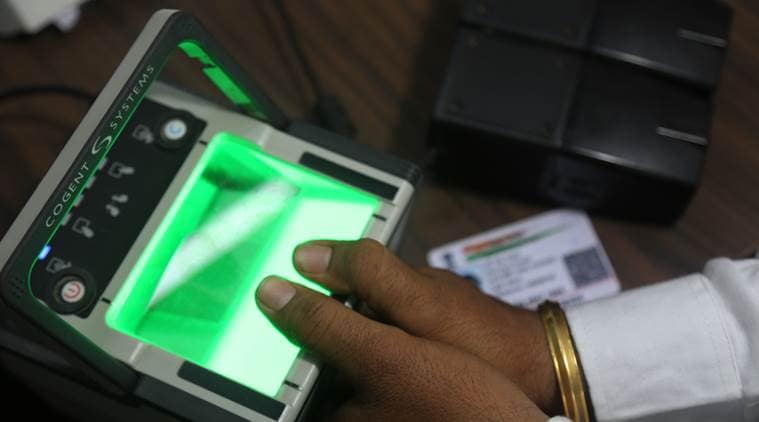Ill fares Aadhaar
There is little to show by way of Aadhaar benefits for the poor. And the costs are staring at us.

Aadhaar linking often fails because a person’s demographic details in the Aadhaar database do not match the corresponding details in her job card or ration card. (Express photo by Abhinav Saha)
Despite some thoughtful lines, the recent Supreme Court judgment on Aadhaarperpetuates double standards in the way Aadhaar is imposed on the poor and the privileged. The middle class is largely off the hook, except for the compulsory linkage with PAN cards. The poor, however, are left where they were — exposed to the ordeal of Aadhaar seeding and authentication for every social benefit, however tiny.
The majority opinion, it seems, was swayed by claims that Aadhaar empowers the poor (whatever that means), and that exclusion problems are little more than anecdotes. Contrary to these claims, there is considerable evidence of mass damage. Here are three examples.
One example is the discontinuation of social benefits for want of Aadhaar seeding. When benefits are paid through Aadhaar-enabled means such as the Aadhaar Payments Bridge System (APBS), the first step is to seed the list of beneficiaries with the corresponding Aadhaar numbers. For instance, APBS payment of social security pensions requires tagging each pensioner in the list with an Aadhaar number. Often, what is actually required is “double seeding”. In this example, aside from the list of pensioners, each pensioner’s bank account also needs to be linked with Aadhaar. Similarly, to receive their wages through APBS, workers employed under the employment guarantee scheme need to link their job card and bank account with Aadhaar.
Seeding is a tedious operation and it has to be done each time a new scheme is inducted. The simplest way of fast-tracking it is the “ultimatum method”. This consists of telling people that unless they link their bank account or pension with Aadhaar by a given date, their benefits will be discontinued. The ultimatum method does not work well with the privileged classes, because they tend to oppose or ignore the deadline, which gets repeatedly postponed, defeating the purpose. It is the government’s attempt to use the ultimatum method for SIM cards and banks accounts that led to some resentment against Aadhaar among the middle classes, and eventually, to the recent judgment in their favour.
With poor people, however, the ultimatum method works fine. After the deadline, those who have failed to comply are simply removed from the lists. Poor people often find themselves deprived of their rights in the process. Indeed, linking one’s pension or ration card or bank account with Aadhaar is not a simple matter. The person concerned may not know what she has to do. She may not be able or willing to pay the requisite bribes. Data-entry errors are common. And even without such errors, Aadhaar linking often fails because a person’s demographic details in the Aadhaar database do not match the corresponding details in her job card or ration card.
Instead of addressing these issues, the government typically declares that all the deleted names are “fake” and counts the discontinued benefits as “Aadhaar-enabled savings”. We know for a fact that job cards, ration cards and pensions have been mass-cancelled in many states. Quite likely, the same happened with other benefits such as scholarships. Even maternity benefits are routinely held up by the hassles and hazards of double seeding.
Another example of mass damage relates to the use of Aadhaar-based biometric authentication (ABBA) in the public distribution system. ABBA requires not only Aadhaar seeding, but also successful fingerprint authentication at the ration shop every month. That, in turn, requires a functional Point of Sale (PoS) machine, adequate connectivity, and reasonably smooth fingers. Despite some alleged safeguards, the system is “far from perfect”, as Charlie Chaplin put it when the parachute failed to open. Whenever ABBA has been imposed in the PDS, large numbers of poor people have been deprived of their food rations. Meanwhile, evidence from Jharkhand suggests that ABBA is of little use in reducing PDS corruption. Nevertheless, the central government is determined to make ABBA compulsory for food rations, with cosmetic exemptions.
A third example is the disruption (in a negative sense) of the banking system. This has many aspects. A myth has been created that Aadhaar enabled millions of people to open Jan Dhan Yojana accounts within minutes, using biometric authentication. In fact, most of these accounts were opened without biometric authentication, by seeding Aadhaar numbers from Aadhaar cards or even second-hand information. Biometric verification (in the form of “e-KYC”) was imposed later on, and became a serious ordeal for poor people. Failure of e-KYC often led to discontinuation of benefit payments, or to people being locked out of their accounts, temporarily or permanently. Another source of confusion is the APBS’s “last Aadhaar-linked account” (LALA) rule, whereby Aadhaar becomes a financial address and money is automatically sent to a person’s LALA. This rule often sent people’s money to unwanted or unknown destinations, such as someone else’s account or an Airtel wallet. The pathologies of e-KYC, the LALA rule and related norms are in danger of undermining people’s confidence in the banking system.
None of this is to say that Aadhaar is always useless as far as welfare schemes are concerned. Some constructive applications may be possible. Ten years after Aadhaar was launched, however, there is little to show by way of benefits of Aadhaar for poor people. The costs, on the other hand, are staring at us. As for official estimates of Aadhaar-enabled savings, they stand no scrutiny whatsoever.
The Supreme Court, unfortunately, seems influenced by the tall claims of what might be called the coalition of Aadhaar champions (COACH). The COACH is largely an offshoot of the software industry, which has considerable power in India. Its open ambition is to use Aadhaar as a “platform” to build wide-ranging applications. Most of these applications have nothing to do with welfare schemes. No doubt some COACH leaders believe in good faith that Aadhaar empowers the poor, but ultimately, the profit motive looms large. In this and other ways, the COACH is shot through with conflicts of interest. In fact, it is a startling example of corporate invasion of public policy, with business consultants packing government committees, drafting laws, harvesting lucrative contracts and orchestrating Aadhaar’s public relations.
Predictably, the COACH went into overdrive after the Aadhaar judgement, with instant editorials aimed at setting the framework of public debate. This propaganda technique has paid off, ever since Aadhaar was sold as a “voluntary facility”. More recently, the COACH managed to frame the Aadhaar debate as a trade-off between welfare and privacy, and then downplayed the privacy concerns. This framework hides the fact that the welfare gains from Aadhaar are not clear in the first place.
The writer is visiting professor at the Department of Economics, Ranchi University
For all the latest Opinion News, download Indian Express App
More From Jean Dreze
- Hollowing out a promiseNREGA is a demand-driven programme and if the demand vanishes because wages are low and uncertain, nothing will be able to save it...
- Know your AadhaarBill Gates’s claim that it raises no privacy concerns is misleading. Crucial issues that have to do with confidentiality of data and state surveillance are…
- Dissent and AadhaarWe have been numbed by a series of lies, myths and fictions about the project...







































No hay comentarios:
Publicar un comentario